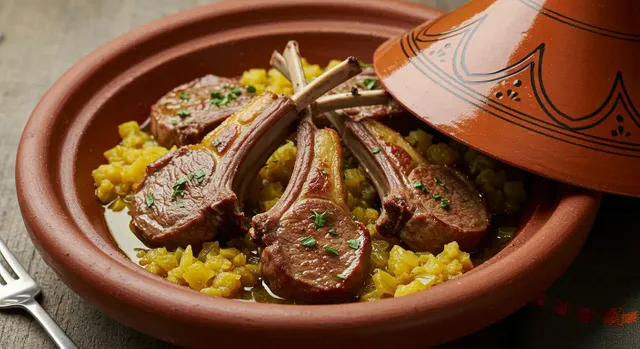Lamb Chops Cooked in a Tajine
Imagine a dish that embodies the rich culinary heritage of Morocco, where the tender flavors of lamb chops meld with the aromatic spices of North Africa. Lamb chops cooked in a tajine is an age-old tradition that brings forth a truly authentic flavor profile, characteristic of this iconic clay pot.
The beauty of this Moroccan lamb recipe lies in its simplicity and the depth of flavor it achieves. By slow-cooking the lamb chops in a Tajine, the meat becomes tender and infused with the surrounding spices, creating an authentic Tajine dish that is both hearty and aromatic.
Tajine cooking, a staple of Moroccan cuisine, has a fascinating history that reflects the country’s cultural diversity. This traditional method of cooking has been a cornerstone of North African cuisine for centuries, with its roots tracing back to the Berber communities.
The Cultural Significance of Tajine in North African Cuisine
The Tajine is more than just a cooking vessel; it’s a symbol of hospitality and community in North African culture. In Morocco, Tajine dishes are often served on special occasions and gatherings, highlighting the importance of sharing meals as a way of bringing people together. The slow-cooked meals prepared in a Tajine are not only flavorful but also represent the rich culinary traditions of the region.
Key aspects of Tajine’s cultural significance include:
Symbol of hospitality
Central to community gatherings
Representation of culinary traditions
Cultural Aspect Significance in Tajine Cooking
Hospitality Tajine dishes are often served to guests as a sign of respect and generosity.
Community Tajine cooking brings people together, fostering a sense of community and togetherness.
Tradition The Tajine is a link to the past, preserving traditional cooking methods and recipes.
How Tajine Cooking Has Evolved Over Centuries
Over time, Tajine cooking has evolved, influenced by various cultures including Arab, Mediterranean, and African cuisines. This evolution is reflected in the diverse range of ingredients and spices used in Tajine recipes today. Despite these changes, the fundamental technique of slow-cooking in a clay pot remains unchanged, preserving the essence of traditional Tajine cooking.
The evolution of Tajine cooking is a testament to the dynamic nature of culinary traditions, adapting to new influences while maintaining their core identity.
Understanding the Tajine: The Unique Cooking Vessel
Moroccan Lamb Chops Cooked in a Tajine
At the heart of traditional Tajine cooking lies a distinctive, conical-shaped cooking vessel that has captured the hearts of chefs worldwide. The Tajine is not just a pot; it’s a symbol of Moroccan culinary heritage and a testament to the country’s rich gastronomic history.
Anatomy of a Traditional Tajine Pot
A traditional Tajine pot is characterized by its unique conical lid, which is designed to allow steam to rise and condense, thereby returning moisture to the dish. This ingenious design enables slow cooking, ensuring that the flavors are rich and the meat is tender.
The base of the Tajine is typically wide and shallow, allowing for even heat distribution. This is crucial for cooking methods that involve slow simmering or braising.
Clay vs. Ceramic vs. Cast Iron Tajines
Tajines are made from various materials, each with its own advantages:
Material Characteristics
Clay Traditional, porous, and ideal for slow cooking. Requires seasoning.
Ceramic Durable, non-reactive, and easy to clean. Suitable for various cooking techniques.
Cast Iron Excellent heat retention, versatile, and can be used at high heat. Requires maintenance.
Preparing Your Tajine for First Use
Before using your Tajine for the first time, it’s essential to prepare it properly. For clay Tajines, this involves soaking the pot in water for several hours. Ceramic and cast iron Tajines may require seasoning or a simple wash with soap and water.
As one culinary expert notes, “The key to a successful Tajine dish lies not just in the ingredients, but in the preparation and care of the cooking vessel itself.”
By understanding and properly using your Tajine, you’ll be well on your way to creating delicious, authentic Moroccan dishes like the easy lamb Tajine recipe.
Essential Ingredients for Lamb Chops Cooked in a Tajine
The foundation of a delicious lamb tajine lies in the quality and authenticity of its ingredients. To create an authentic Moroccan dish, it’s crucial to select the right components that will bring out the rich flavors and aromas characteristic of this traditional North African recipe.
Selecting the Perfect Lamb Chops
For lamb chops cooked in a tajine, the quality of the lamb is paramount. Opt for high-quality lamb chops that are preferably grass-fed and have a good balance of meat and fat. The thickness of the chops can vary, but generally, 1-1.5 inches is ideal for achieving tender results.
Traditional Moroccan Spices and Their Flavor Profiles
Moroccan cuisine is renowned for its complex spice blends, and the tajine is no exception. The use of traditional Moroccan spices is what gives the lamb its distinctive flavor.
Ras el Hanout: The Signature Spice Blend
Ras el Hanout, which translates to “head of the shop,” is a blend of the finest spices available. It’s a complex mix that can include over 30 different spices, such as cumin, coriander, cinnamon, and cardamom. This signature blend is the cornerstone of many Moroccan dishes, including lamb tajine.
Complementary Herbs and Spices
In addition to Ras el Hanout, other herbs and spices complement the lamb’s flavor. These include fresh parsley, cilantro, and ginger, which add freshness and depth to the dish.
Regional Spice Variations
Morocco’s diverse regions each have their own twist on spice blends. For instance, the Berber region is known for its use of more chili peppers and robust flavors, while coastal regions might incorporate more seafood-inspired spices.
Spice/Herb Flavor Profile Usage
Ras el Hanout Complex, aromatic Main spice blend
Parsley Fresh, green Garnish, added freshness
Ginger Spicy, warm Adds depth
See all the ingredients and print the recipe on : https://www.bestonfood.com/lamb-chops-cooked-in-a-tajine/

